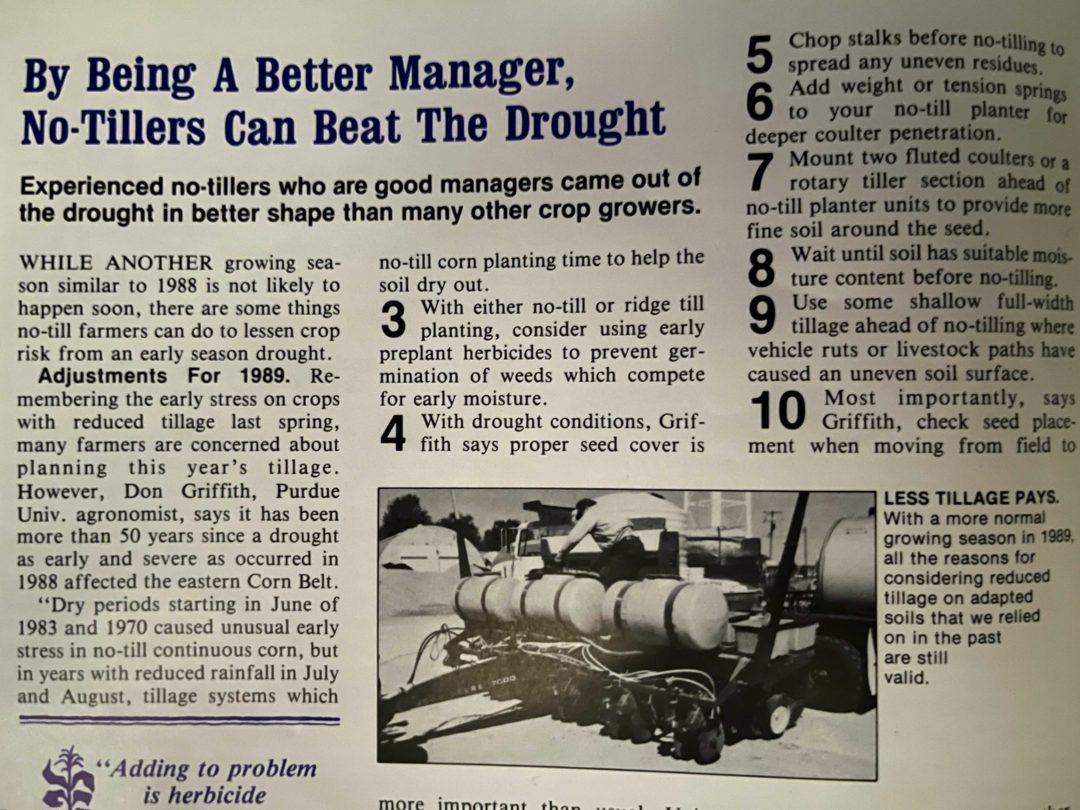Editor’s Note: Ongoing drought conditions in the Corn Belt and beyond have some no-tillers concerned that 2023 could turn out as dry as 1988. The drought of 1988 was the worst in the U.S. since the Dust Bowl and led to significant crop losses, with an average corn yield of 73 bushels per acre in Illinois. Overall, the drought caused $148 billion (in today’s dollars) of damages.
No-Till Farmer’s editors revisited the 1988-89 newsletter archives to identify top tips for dealing with severe drought. Read this article from the March 1989 issue to learn from the past.
While another growing season similar to 1988 is not likely to happen soon, there are some things no-till farmers can do to lessen crop risk from an early season drought.
Adjustment for 1989. Remembering the early stress on crops with reduced tillage last spring, many farmers are concerned about planning this year’s tillage. However, Don Griffith, Purdue Univ. agronomist, says it has been more than 50 years since a drought as early and severe as occurred in 1988 affected the eastern corn belt.
“Dry periods starting in June of 1983 and 1973 caused unusual early stress in no-till continuous corn, but in years with reduced rainfall in July and August, tillage systems which leave surface residue have often showed less crop stress than plow and chisel systems,” says Griffith.
Complicating tillage choices for 1989 is the possibility of herbicide carryover due to low rainfall when rotating to another crop.
“On erodible and drouthy soils, planting corn after corn and soybean after soybeans for 1 year with conservation tillage may be a better choice than deep tillage,” adds Griffith. “The expected yield advantage for no-till or ridge planting on these soils may offset the 7-10% yield loss that is common with monoculture. In addition, the soils will be protected from serious soil loss due to erosion.”
Critical concerns. Griffith says that the following ideas fall into the category of good management practices for reduced tillage systems:
- When no-tilling into cover crops or established sod, kill the growing crop 2-3 weeks before no-tilling well drained soils.
- On poorly drained soils, the living cover may be needed until no-till corn planting time to help the soil dry out.
- With either no-till or ridge till planting, consider using early preplant herbicides to prevent germination of weeds which compete for early moisture.
- With drought conditions, Griffith says proper seed cover is more important than usual. Uniform seed placement and closing of the no-till coulter slot are sometimes difficult due to dense soils, non-uniform soil surface or improper planter placement. A ½-inch rain within a few days after no-tilling often masks poor seed placement. But when it is dry after planting, improper seed cover can lead to poor germination, poor development of the secondary root system and insect damage to corn.
- Chop stalks before no-tilling to spread any uneven residues.
- Add weight or tension springs to your no-till planter for deeper coulter penetration.
- Mount two fluted coulters or a rotary tiller section ahead of no-till planter units to provide more fine soil around the seed.
- Wait until soil has suitable moisture content before no-tilling.
- Use some shallow full-width tillage ahead of no-tilling where vehicle ruts or livestock paths have caused an uneven soil surface.
- Most importantly, says Griffith, check seed placement when moving from field to field or from one soil type to another within the same field. When seed is not properly covered up, stop no-tilling until corrections are made.
“If we assume a more growing season for 1989, the reasons for considering reduced tillage in the past on soils where adapted should be just as valid this year,” concludes Griffith. “These may include erosion control, cost savings and more timely planting. With good management of the reduced tillage system, these goals should be realized in 1989.”
Related Content
How No-Till Can Help Your Operation Survive Drought Conditions
No-Till & Cover Crops Paying Off in Drought Conditions
[Podcast] How Australian No-Tillers Farm Through Years of Drought







Post a comment
Report Abusive Comment